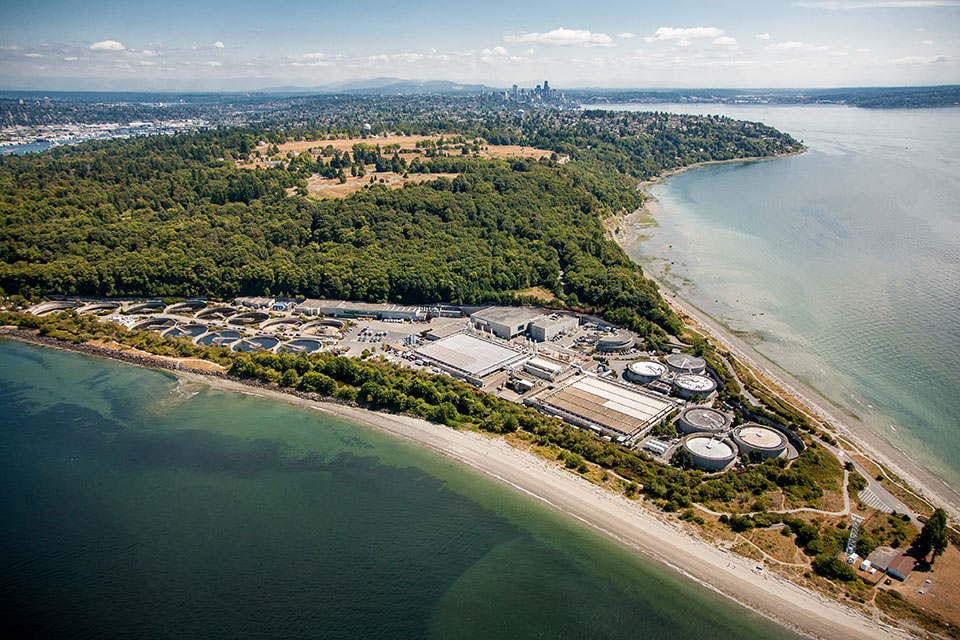By Julia Davis
New approaches from the Winkler Lab aim to protect waterways by improving nitrogen removal without expanding wastewater plants.

The West Point Treatment Plant, pictured here, is the site of the Winkler Lab’s ongoing pilot project to improve nitrogen removal without building additional tanks. Photo courtesy of King County.
Most wastewater treatment plants were built to remove carbon — organic waste that bacteria can easily break down. But nitrogen, found in human waste, is harder to eliminate. When released untreated into waterways, nitrogen can cause environmental problems like algal blooms, which damage ecosystems.
To remove nitrogen, treatment plants need slow-growing bacteria that perform specialized conversions, but those bacteria tend to get flushed out of traditional systems before they can finish the job. Keeping them in the system longer typically requires building additional tanks or clarifiers, which are expensive, take up space and take years to construct.
To address this challenge, the Winkler Lab has piloted new biofilm technologies, like hydrogel beads and plant-based carriers, that help nitrogen-removing bacteria stay in the system.
“The goal is to retrofit existing plants for nitrogen removal, without needing to expand their footprint,” says Mari Winkler, John R. Kiely Endowed Professor.
The lab recently ran pilot projects in Everett, Edmonds and Seattle’s West Point Treatment Plant. Each tested a different method for supporting bacterial growth and improving treatment performance.
In Everett, research scientist Bruce Godfrey tested hydrogel beads filled with a unique type of bacteria called anammox. These bacteria remove nitrogen without needing oxygen or organic carbon, skipping a major step in traditional treatment. That step, called aeration, involves bubbling air through tanks to feed bacteria — a process that consumes large amounts of electricity.
“The traditional method to treat sewage is bubbling air into it, which grows a bunch of bacteria, but also requires pumping the air in using compressors,” says Godfrey. “That uses a huge amount of electricity. With anammox, you can cut energy use by more than half.”
In Edmonds and West Point, the lab tested biodegradable carriers made from kenaf, a fibrous plant material. These carriers float in the tank and act like scaffolding, giving bacteria a surface to grow on and form sticky biofilms that stay in the system. Screens and rotating drums keep the kenaf from washing away.
“I often call the kenaf an affordable housing program for these nitrogen-removing bacteria,” says Bao Nguyen Quoc (CEE Ph.D. ‘22), who led the Edmonds pilot. “Conventional wastewater systems are only set up for fast-growing bacteria. The slower microbes needed for nitrogen removal need something to cling to, or they get washed out. The kenaf gives them a place to grow, so they can stay in the system and increase nitrogen removal without expanding the footprint of the treatment plant.”
We’re finding ways to treat more water, remove nitrogen and minimize energy use — all without needing to build new infrastructure.”
At West Point, CEE Ph.D. candidate Brian Roman is leading an ongoing pilot that simulates conditions at King County’s South Plant, one of the county’s largest wastewater treatment plants, where this technology is being considered for installation. Like Edmonds, it’s testing how kenaf can boost nitrogen removal without requiring additional tanks — an increasingly important goal as growing urban density limits opportunities to expand treatment facilities.
“With more people populating Seattle, there’s more wastewater, but no room to grow the treatment plants,” says Roman. “This technology helps us treat more water in the same space by intensifying the system and adding nitrogen treatment, which most plants weren’t originally designed to handle.”
While all three pilots are still under evaluation, they show strong potential as scalable solutions, and some utilities are already exploring the next steps for implementation.
Together, these pilot projects point to a future where existing treatment plants can meet stricter environmental regulations without costly new construction, something Winkler is excited to support.
“We’re finding ways to treat more water, remove nitrogen and minimize energy use — all without needing to build new infrastructure.”
Originally published April 28, 2025